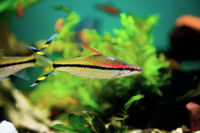Red Line Torpedo Barb (Sahyadria denisonii)
From The Aquarium Wiki
(Redirected from Puntius denisonii)
Red Line Torpedo Barb
Sahyadria denisonii
208 Litres (55 US G.)
12-15 cm (4.7-5.9")
Freshwater
6.8 - 7.8
20 -25 °C (68-77°F)
5-25 °d
1:2 M:F
5-8 years
Family
Cyprinidae
This animal is available captive bred
Contents
Additional names
- Red Line Torpedo Barb, Denison Barb, Rose Line Shark
Additional scientific names
- Barbus denisonii, Labeo denisonii, Crossocheilus denisonii, Puntius denisoni, Puntius denisonii
Origin[edit]
- It is endemic to the fast- flowing hill streams and rivers of the state of Kerala and South Karnataka in South India.
Sexing[edit]
- It is not easy to visually sex this fish. Mature females, however, should be rounder in the belly.
Tank compatibility[edit]
- A shoaling fish that may be nippy and aggressive if kept in too small a group, keep a minimum of 5 individuals. They should be kept with other similar fish which appreciate similar conditions such as Danios.
Diet[edit]
- Not a picky eater, but does better on live foods such as bloodworm and brine shrimp.
Feeding regime[edit]
- Feed once or twice a day.
Environment specifics[edit]
- This fish prefers a well oxygenated and mature tank with some current. They do best with a sand or small gravel substrate, light planting and hiding places in bogwood. They prefer cooler temperatures than other "tropical" fish.
Behaviour[edit]
- An active fish that should have plenty of swimming room.
Identification[edit]
- A distinctive torpedo-shaped fish. The caudal fin is forked and tipped in black and yellow. The body is silver with green/yellow iridescence, it has a bold black lateral line running from the tip of the nose to the caudal peduncle. There is a bright red lateral band above the black running from the tip of the nose to the mid section of the body, giving this fish it's common name. The dorsal fin also has some red colouration, the other fins are translucent.
Species Note[edit]
- Due to over-collecting for the pet trade this fish is now becoming increasingly endangered in the wild, therefore, it is best these are not bought for the time being unless they are confirmed to be captive bred specimens. If you are considering this fish perhaps consider a breeding project instead of just an average community tank addition.[1][2]
Pictures[edit]
Videos[edit]
References[edit]
- ↑ Practical Fishkeeping Article Matt Clarke: 20.11.2008 "Puntius denisonii threatened by aquarium trade"
- ↑ Practical Fishkeeping Article Matt Clarke: 9.2.2009 "Puntius denisonii breeding programme announced"
External links[edit]
- Fishbase (Mirrors:
 )
)



